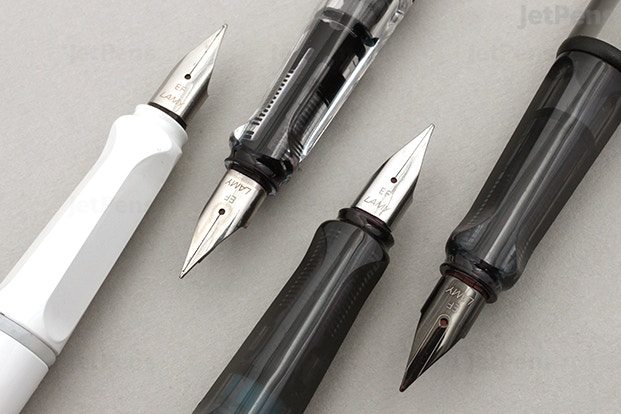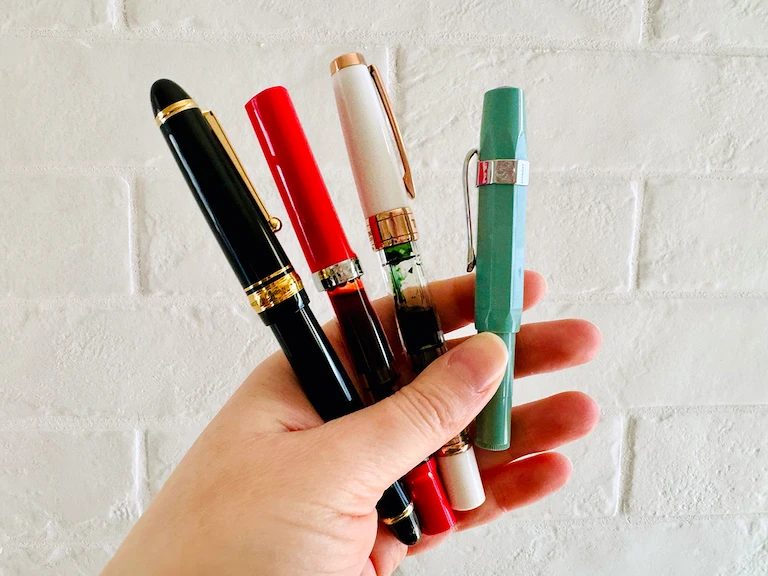A lefty’s journey into fountain pens
In August 2022, I was casually browsing through Jetpens (as one does), and thought I might like to give fountain pens one last try. I’m lefthanded, and the fountain pens I tried in the past felt scratchy and difficult to write with. But they seemed so neat!
I found and ordered a Lamy Safari with a left-handed nib. Their lefty nibs are similar to a Western medium-sized nib, and have a special grind that is supposed to help south paws push their nib across the page (right-handed people use a “pull” action). I had no idea how well it would work for me, but figured why not give it one more shot?
It. worked.
Funnily enough, the left-handed nib that I ordered that day wasn’t the important unlock for my fountain pen journey. It was actually the triangular grip on the Lamy Safari:

This triangular grip encourages your fingers (middle, pointer, thumb) to naturally create what Jetpens calls a “tripod position”.
That grip was so important for me because naturally I am a “side writer”. Side writers push the pen across the page, with their hand passing directly over the lines they’re writing. This is the absolute worst writing position (AFAICT) if you hate smudging, or if you want to use a pen without that scratchy feeling.
The tripod finger positioning enabled me to become an “under writer”, which entails holding the pen beneath the line that you’re currently writing. Writing with your hand under the line helps avoid smearing and scratching. This blog post has images illustrating these writing positions.
I had actually tried learning to become an underwriter previously, but it made absolutely zero sense to my mind—until I got my literal hands on a Lamy Safari, and my fingers fell right into place.
My journey since then
Because the Lamy Safari trained me to become an underwriter, I felt I could use any fountain pen (FP) or ink I wanted. And boy…have I purchased a few. One thing you’ll find in the FP community is that people often go a little wild at first and buy a lot of pens. I’m in camp “this is actually a good thing”, because you won’t know what you really like until you try a few different options.
My favorite pens

“Everyday drivers”: for the main “body copy” of my journals, I like to use Pilot fountain pens. These are among my most expensive pens. For my Hobonichi “memory keeping” journal I have a Pilot Custom NS (M nib) and a Pilot Custom 743 (F). For my pocket bullet journal, I use a Pilot Vanishing Point Decimo (F). I was so surprised that I actually really liked a “clicky” fountain pen. It’s a perfect companion for a small notebook on the go. Pen Sachi, where I bought most of these, runs sales from time to time, so keep an eye out for those.
Companion pens: for the headings and special text in my journal, I use TWSBI Eco (F, M, stub nibs) and Kaweco Sport (F) pens. I actually collect TWSBI Eco/Eco-T pens that have opaque colored caps. I loooove how much ink they can hold, and they don’t dry out when I leave them in a drawer for awhile. My jam is matching ink and pen colors. I rotate the colors I use in my journal monthly.
Cheap pens for travel: aesthetically Platinum Preppys are not my fave, but they write so well for such a cheap pen (~$7 USD). The caps click on nice and securely, so these are a great option to travel with.
Pens I’m not a fan of
There are many pens I haven’t bothered trying out, since I don’t like the aesthetics or they’re too expensive for me to be interested in. A couple of not-favorites include:
- Sailor brand: I have a couple Sailor Pro Gear Slims, which are among my most expensive pens. They are SO CUTE, I love how they feel in the hand, but the writing experience with Sailor nibs is not my favorite. Sailor nibs are known for having a bit more “feedback”; they can feel somewhat like a pencil. I didn’t have an opportunity to try these before I bought them. I wish I had, because I want to like them more than I actually do.
- Platinum Century 3776: I tried this at a pen show and wasn’t jazzed about how it wrote, which is strange considering I like their cheapies so much.
- Pilot Kakuno: this is an inexpensive (~$12 USD) pen intended for kids, and it’s so cute but it’s scratchy as all hell. So funny that I like expensive Pilots and dislike the cheap ones, and the reverse is true for Platinum. Just goes to show you have to try things for yourself.
The pen I truly want
Give me a Pilot nib in a Sailor body!! Pilot makes the best nibs that I’ve tried, but they are not adventurous in terms of pen body colors/aesthetics. That’s at least true of the pens that make it across the pond here in the U.S.; the Japanese market tends to have exclusive models.
Ink brands I like
- Pilot Iroshizuku makes bright, saturated inks that write “wet” and are easy to clean out of pens. Special properties are limited to a bit of sheen.
- Diamine makes well-behaved inks with a variety of properties. Their “Inkvent” calendar is a fun way to try a lot of types of inks without committing to a huge bottle (here be lots of shimmer inks).
- Sailor has interesting, muted colors that exhibit beautiful shading.
- I only have two inks from Taccia but I use Taccia Ainezu constantly in my bullet journal. It’s a complex, grey ink with blue-ish undertones.
Your own fountain pen journey
If you’re interested in using fountain pens yourself, my biggest recommendation is to try a variety of options to see what works best for you. The Lamy Safari’s triangular grip was the unlock for me, but other people really don’t like that grip.
Some quick tips as you explore:
- If you’re interested in trying an expensive pen before committing to it, see if you have any pen shows, stationery meetups, or stationery stores in your area. You might be able to test drive the model before buying.
- A higher price point does not necessarily mean you’ll like a pen’s writing experience more.
- To expand your ink options, use converters, or refill cartridges with your own inks. Some retailers, like Goulet Pens, sell ink samples for a couple dollars each. This can allow you to try out lots of different inks before committing to a full bottle. You will still end up with more ink than you can use in a lifetime, probably.
- Only fountain pen ink goes in a fountain pen!!! Don’t put India ink in a fountain pen—it will clog.
- If you’re a lefty and underwriting doesn’t work for you, look for fast-drying inks and uncoated paper. I love Tomoe River Paper for the properties it brings out in inks, but ink dries slowly on TRP and sits on top of the paper rather than “sinking in”. Leuchtturm’s paper, in my experience, works better for faster-drying experiences.
Above all, enjoy your own fountain pen journey!